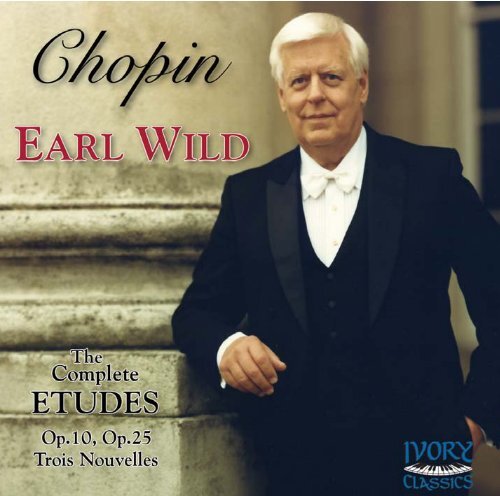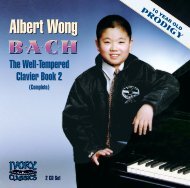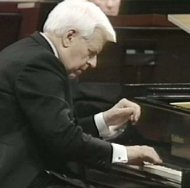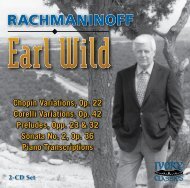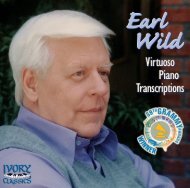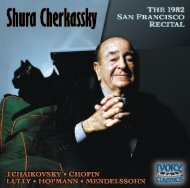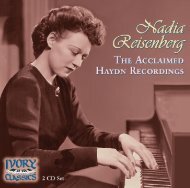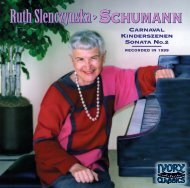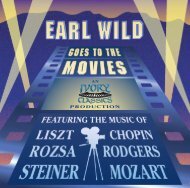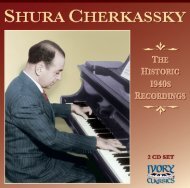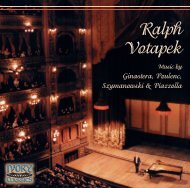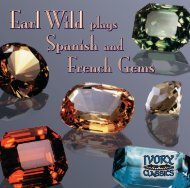IC 76003 Booklet - Ivory Classics
IC 76003 Booklet - Ivory Classics
IC 76003 Booklet - Ivory Classics
Create successful ePaper yourself
Turn your PDF publications into a flip-book with our unique Google optimized e-Paper software.
Accolades<br />
7<br />
“Earl Wild is still Earl Wild”<br />
“The reason Mr. Wild’s Chopin keeps us<br />
unfailingly mesmerzerized is the endless and<br />
absoulte poetry of his glowing performance.”<br />
“No rickety joints here at 77, just pure motion<br />
and artistry, with the fluid technique and<br />
musical depth of a seasoned artist.”<br />
“This is Mr. Wild’s ‘magic’, with age has<br />
come a great wondrous wisdom.”
Chopin Etudes<br />
EARL WILD<br />
Twelve Etudes, Op. 10 Twelve Etudes, Op. 25<br />
1) No. 1 in C Major 2:15 13) No. 1 in A-flat Major 2:40<br />
2) No. 2 in A minor 1:35 14) No. 2 in F minor 1:30<br />
3) No. 3 in E Major 4:26 15) No. 3 in F Major 1:51<br />
4) No. 4 in C-sharp minor 2:07 16) No. 4 in A minor 1:51<br />
5) No. 5 in G-flat Major 1:43 17) No. 5 in E minor 3:11<br />
6) No. 6 in E-flat minor 3:45 18) No. 6 in G-sharp minor 2:02<br />
7) No. 7 in C Major 1:36 19) No. 7 in C-sharp minor 5:03<br />
8) No. 8 in F Major 2:26 20) No. 8 in D-flat Major 1:10<br />
9) No. 9 in F minor 2:04 21) No. 9 in G-flat Major :58<br />
10) No. 10 in A-flat Major 2:09 22) No. 10 in B minor 3:46<br />
11) No. 11 in E-flat Major 2:30 23) No. 11 in A minor 3:38<br />
12) No. 12 in C minor 2:32 24) No. 12 in C minor 2:39<br />
Trois Nouvelles Etudes<br />
25) No. 1 in F minor 2:15<br />
26) No. 2 in A-flat Major 1:46<br />
27) No. 3 in D-flat Major 1:48<br />
Total Time: 66:48<br />
– 2 –
Frédéric Chopin (1810-1849)<br />
The Complete ETUDES<br />
The tragedy that so brilliant a prodigy as Frédéric Chopin should have<br />
lived so brief a life is one of the great laments of humankind. Born in 1810<br />
in Zelazowa Wola, Poland, he was dead by the year 1849, when at age thirty-nine<br />
he succumbed to frailty and sickliness in Paris, which had been his<br />
home since 1831. As a pianist he performed in public only rarely and reluctantly,<br />
in an exquisitely delicate and ephemeral style. In 1836 Henrietta Voigt<br />
said that “wonderful is the ease with which his velvet fingers glide, I might<br />
say fly, over the keys… What delighted me was the childlike, natural manner<br />
which he showed in his demeanor and in his playing.”<br />
Though Chopin’s hands were not large, they were flexible, enabling him<br />
to maneuver wide stretches without the least apparent exertion. According to<br />
Carl Mikuli he recommended bending the wrist inward and outward and<br />
pressing the fingers apart, but without over-exertion. For practicing scales he<br />
insisted on a very full tone, as legato as possible, with metronomic steadiness.<br />
Perhaps most importantly, he held that evenness in playing scales and arpeggios<br />
depended not only on the equality of strength of the five fingers, “and a<br />
perfect freedom of the thumb in passing under and over, but foremostly on<br />
the perfectly smooth and constant sideways movement of the hand (not step<br />
by step), letting the elbow hang down freely and loosely at all times.” He<br />
– 3 –
taught scales with many black notes first (the C major scale came last as the<br />
most difficult), using the thumb on the black notes and sometimes passing it<br />
under the fifth finger (with a necessary bend of the wrist).<br />
The piano was in transition in Chopin’s day, having evolved from a delicate<br />
wooden instrument to a bold instrument with a very different key<br />
action and a reinforced soundboard, allowing richer sympathetic vibrations<br />
and increased carrying power for the concert hall. In Paris at that time there<br />
were some 180 manufacturers producing a wide range of experimental<br />
pianos, leading its citizens to refer to their city as Pianopolis. Some manufacturers<br />
developed a more expressive instrument, one equal to the demands<br />
of Chopin’s works.<br />
Countless piano studies were composed in the eighteenth century and<br />
early in the nineteenth by the likes of Berger, Moscheles, Hummel, Steibelt,<br />
Reicha, Czerny, Cramer, Kalkbrenner and Clementi. Their starkly educational<br />
purpose was strictly to perfect the techniques needed to play the repertoire<br />
of the day, and they thus lacked the musical and affective properties required<br />
for pieces intended for the public. Chopin’s etudes, however—twenty-seven<br />
of them in all—eclipsed the earlier models and led piano technique to the<br />
next logical step, exploiting the new resources of the evolving instrument,<br />
and all its color possibilities, and exploring revolutionary techniques through<br />
their stunning inventiveness. Each study concentrates on a single technical<br />
problem and fully exploits the possibilities of the human hand, so much so<br />
that a leery Ludwig Rellstab wrote that “those who have crooked fingers may<br />
put them right by practicing these studies; but those who have not, should<br />
– 4 –
not play them, at least not without having a surgeon at hand.” Composed<br />
between 1829 and 1839 (in a sequence different from their numbering), the<br />
etudes represent Chopin’s early maturity—written between his late teens and<br />
his late twenties—and possess a youthful vigor not seen in his later works.<br />
They launched the modern school of piano playing.<br />
But the real genius of the etudes lies in the poetry by which they surpass<br />
all precedents, thus constituting the new genre of the concert-etude. They are<br />
boldly creative expressions of human emotion, studies in mood, inventively<br />
encapsulated in vignettes of virtuosity. Chopin admonished his students to<br />
make the piano sing and to express personal emotion, never using technical<br />
exercises in a mechanical way, but investing them with intelligence and will.<br />
Indeed, the etudes succeed resoundingly at melding formidable technique<br />
with fresh musical expression. As James Huneker has written: The etudes are<br />
“not only the foundation of [Chopin’s] technical system—a system new to<br />
pianism when they appeared—but they also comprise some of his most imaginative<br />
and enchanting creations, judged exclusively from the musical point<br />
of view.” All the etudes are marked either allegro, vivace, presto or agitato—<br />
apart from three lentos and two andantes—making them fiendishly difficult<br />
pieces and explaining why they are the only Chopin works Arthur Rubinstein<br />
refused to record (Although Mr. Wild performed the complete etudes many<br />
times throughout his career, he waited to record them until he was seventyseven).<br />
They have appeared in a number of editions over the years.<br />
Chopin wrote of his etudes that he “tried to put not only science but<br />
also art into them. Since a virtuoso must practice for a long time, he should<br />
– 5 –
e given exercises in which he will find proper food for his ears and his soul<br />
lest he be bored to death. I am disturbed because there are no beautiful exercises<br />
for beginners. A virtuoso has everything open to him; when he is bored<br />
by exercises, he can reach out for the most beautiful music. But a poor fellow<br />
who cannot play anything except exercises, whose fingers are as though<br />
tied, needs beautiful exercises that will save him from becoming disgusted<br />
with music. I have tried to write something of this kind, but I haven’t been<br />
successful, because for the beginner anything is too difficult.”<br />
Pianists began recording Chopin’s etudes in the nineteenth century. The<br />
earliest were probably the random samplings of them by a variety of pianists<br />
(including Horowitz) who recorded single movements on the pneumatic<br />
Welte-Mignon recording system, perfected in the 1890s. In terms of fidelity,<br />
the device far exceeded all other approaches to piano roles, including especially<br />
the gramophone and cylinder records of the period. But the first<br />
pianist to record the complete opus 10 and 25 was Wilhelm Backhaus.<br />
The opus 10 etudes were published as a set in 1833 and dedicated to<br />
Franz Liszt, whom Chopin considered their best interpreter. No. 1 is a study<br />
for extended right-hand arpeggios, often with a stretch of six notes between<br />
adjacent fingers. No. 2 explores chromatic scales for the weak fingers 3, 4<br />
and 5 of the right hand. Chopin said of No. 3 that he had never written so<br />
beautiful a melody. It involves playing three continuous voices with the two<br />
hands, and has been called a study in expression. The sheer velocity and<br />
pyrotechnics of No. 4, with frequent shifts of the melody between the hands,<br />
make it one of the most exciting of the studies. Apart from a single white<br />
– 6 –
note, the right hand in No. 5 plays exclusively black notes, giving it a pentatonic<br />
character. One of the easier pieces, the elegiac melody of No. 6 nevertheless<br />
places musical demands on the performer. A toccata with repeated<br />
notes in the right hand, No. 7 alternates thirds and sixths, the lower note of<br />
which requires changing fingers. With simple chords in the left hand, the<br />
right hand in No. 8 is a study in arpeggios covering the spread of four<br />
octaves. No. 9 is a turbulent study in repeated notes, with arpeggios of a<br />
tenth or more in the left hand. In No. 10 the alternating sixths and broken<br />
octaves require a flexible wrist in rhythms of two against three. Von Bülow<br />
said of it that “anyone who can play this etude in a really finished manner<br />
may be congratulated on having climbed to the highest point of the pianists’<br />
Parnassus.” No. 11 is a study in harp-like chords covering the range of twoand-a-half<br />
octaves in both hands. The only etude known to have been<br />
inspired by events in his life, Chopin is said to have composed No. 12 after<br />
learning that Warsaw had fallen to the Russians. It involves tumultuous<br />
arpeggios in the left hand, and a forbidding melody in octaves in the right.<br />
The opus 25 etudes were published in a single volume in 1837, and are<br />
dedicated to Liszt’s mistress, the Countess Marie d’Agoult who bore his children.<br />
Robert Schumann heard Chopin play No. 1 and wrote: “Imagine an<br />
Aeolian harp having all the scales and the hand of an artist combining them<br />
with all kinds of fantastic embellishments, but always with an audible deep<br />
tone in the bass and a softly singing melody in the treble, and you will get<br />
some idea of Chopin’s playing. When the etude was ended, we felt as<br />
though we had seen a radiant picture in a dream which, half awake, we<br />
– 7 –
ached to recall.” The technical challenge in No. 2 is to play the triplet eighthnotes<br />
in the right hand and the triplet quarter-notes in the left with an unaccented<br />
quality. The capricious No. 3 pits the gestures in the right hand<br />
against those of the left, and layers four motives upon each other in every<br />
beat. No. 4 is a nervous study in syncopation and staccato. No. 5 explores<br />
leggiero and scherzando with grace notes and passing tones, and in the slow<br />
section contains one of Chopin’s most beautiful melodies. No. 6 is a study in<br />
rapid thirds while No. 7, with the sweet sadness of its left-hand melody, is<br />
perhaps the most poetic of the lot. No. 8 is a study in parallel double sixths.<br />
In No. 9 the right hand plays a broken chord and two staccato octaves on<br />
every beat. The furious No. 10 presents the challenge of rapid chromatic<br />
legato octaves in both hands, and has a lyrical middle section. Chopin<br />
warned students that the march-like No. 11 “can be treacherous and dangerous<br />
for the uninitiated.” No. 12 involves fast arpeggios in both hands.<br />
Beginning in m. 40 Mr. Wild plays octaves on the first beat of every measure<br />
in a version favored by Rachmaninoff.<br />
The Trois Nouvelles Etudes, published in 1840 without an opus number,<br />
are erroneously known as the posthumous etudes; in fact they were published<br />
while Chopin was still alive. No. 1 is characterized by the cross rhythms of<br />
triplet quarters against four eighth-notes. Following the example of Liszt, Mr.<br />
Wild plays a repeat beginning at measure 22. No. 2 is a study in three against<br />
two, and No. 3 involves simultaneous staccato and legato in the right hand.<br />
– 8 –<br />
© James E. Frazier 2006
Earl Wild<br />
Earl Wild is a pianist in the grand Romantic tradition. Considered by<br />
many to be the last of the great Romantic pianists, this eminent musician is<br />
known internationally as one of the last in a long line of great virtuoso<br />
pianist / composers. Often heralded as a super virtuoso and one of the<br />
Twentieth Century’s greatest pianists, Earl Wild is a legendary figure performing<br />
throughout the world for over eight decades.<br />
Major recognition is something Mr. Wild has received numerous times<br />
in his long career. He was included in the Philips Records series entitled The<br />
Great Pianists of the 20th Century with a double disc devoted exclusively to<br />
piano transcriptions. He has been featured in TIME Magazine on two separate<br />
occasions, most recently in December of 2000 honoring his eighty-fifth<br />
birthday. One of only a handful of living pianists to merit an entry in The<br />
New Grove Dictionary of Music and Musicians, Mr. Wild is therein described<br />
as a pianist whose technique “is able to encompass even the most difficult<br />
virtuoso works with apparent ease.”<br />
Earl Wild was born on November 26, 1915 in Pittsburgh, Pennsylvania.<br />
As a child Earl Wild’s parents would often play opera overtures (such as the<br />
one from Bellini’s Norma) on their Edison phonograph. At three, he would<br />
go to the family piano, reach up to the keyboard, find the exact notes, and<br />
play along in the same key. At this early age, he displayed the rare gift of<br />
absolute pitch. This and other feats labeled him as a child prodigy and led<br />
– 9 –
immediately to piano lessons.<br />
At six, he had a fluent technique and could read music easily. Before his<br />
twelfth birthday, he was accepted as a pupil of the famous teacher Selmar<br />
Janson, who had studied with Eugen d’Albert (1864-1932) and Xaver<br />
Scharwenka (1850-1924), both students of the great virtuoso pianist / composer<br />
Franz Liszt (1811-1886). He was then placed into a program for artistically<br />
gifted young people at Pittsburgh’s Carnegie Tech (the Institute of<br />
Technology) -- now Carnegie Mellon University. Enrolled throughout Junior<br />
High, High School, and College years, he graduated from Carnegie Tech in<br />
1937. By nineteen, he was a concert hall veteran.<br />
He was invited at the age of twelve to perform on radio station KDKA in<br />
Pittsburgh (the first radio station in the United States). Mr. Wild had already<br />
composed many compositions and piano transcriptions as well as arrangements<br />
for chamber orchestra that were regularly performed on KDKA radio.<br />
At twelve, he made such an impression that he was asked to work for the station<br />
on a regular basis for the next eight years. Mr. Wild was only fourteen<br />
when he was hired to play the Piano and Celeste in the Pittsburgh Symphony<br />
Orchestra under the batons of many different conductors; Otto Klemperer<br />
and Fritz Reiner being two of the more well-known personalities.<br />
Mr. Wild’s other teachers included the great Dutch pianist Egon Petri<br />
(1881-1962), who was a student of Ferruccio Busoni (1866-1924); the distinguished<br />
French pianist Paul Doguereau (1909-2000), who was a pupil of<br />
Ignace Jan Paderewski (1860-1941) and Marguerite Long (1874-1966), who<br />
studied the works of Gabriel Fauré and Claude Debussy with Jean Roger-<br />
– 10 –
Ducasse (1873-1954 - a pupil of Fauré’s), and was a friend and protégé of<br />
Maurice Ravel (1875-1937). Mr. Wild also studied with Helene Barere, the<br />
wife of the famous Russian virtuoso pianist, Simon Barere (1896-1951), and<br />
with Volya Cossack, a pupil of Isidore Philippe (1863-1958), who had studied<br />
with Camille Saint-Saëns (1835-1921).<br />
With immense hands, absolute pitch, graceful stage presence, and<br />
uncanny facility as a sight-reader and improviser, Earl Wild was well<br />
equipped for a lifelong career in music.<br />
During this early teenage period of his career, Earl Wild gave a brilliant<br />
and critically well received performance of Liszt’s First Piano Concerto in E-<br />
flat with Dimitri Mitropoulos and the Minneapolis Symphony in Pittsburgh’s<br />
Syria Mosque Hall. Performing the work without the benefit of a rehearsal.<br />
In 1937, he joined the NBC network in New York City as a staff pianist.<br />
This position included not only the duties of playing solo piano and chamber<br />
recitals, but also performing in the NBC Symphony Orchestra under<br />
conductor Arturo Toscanini. In 1939, when NBC began transmitting its first<br />
commercial live musical telecasts, Mr. Wild became the first artist to perform<br />
a piano recital on U.S. television. In 1942, Toscanini added a dimension to<br />
Earl Wild’s career when he invited him to be the soloist in an NBC radio<br />
broadcast of Gershwin’s Rhapsody in Blue.<br />
It was the first performance of the Rhapsody for both conductor and<br />
pianist, and although Mr. Wild had not yet played any of Gershwin’s other<br />
compositions, he was immediately hailed as the major interpreter of<br />
Gershwin’s music. The youngest (and only) American piano soloist ever to<br />
– 11 –
perform with the NBC Symphony and Maestro Toscanini, Mr. Wild was a<br />
member of the orchestra and worked for the NBC radio and television<br />
network from 1937 to 1944.<br />
During World War II, Mr. Wild served for two years in the United States<br />
Navy as a musician, playing 4th flute in the Navy Band. He also performed<br />
numerous solo piano recitals at the White House for President Franklin D.<br />
Roosevelt and played twenty-one different piano concertos with the U.S.<br />
Navy Symphony Orchestra at the Departmental Auditorium, National<br />
Gallery, and other venues in Washington, D.C. During those two years in<br />
the Navy he was frequently requested to accompany First Lady Eleanor<br />
Roosevelt to her many speaking engagements, where he performed the<br />
National Anthem as a prelude to her speeches.<br />
Upon leaving the Navy in 1944, Mr. Wild moved to the newly formed<br />
American Broadcasting Company (ABC), where his duties consisted of being<br />
staff pianist, conductor, and composer where he conducted and performed<br />
many of his own compositions – he stayed at ABC until 1968. During both<br />
his NBC and ABC affiliations he was also a traveling musician, performing<br />
and conducting many concert engagements around the world. In 1962, the<br />
ABC network commissioned him to compose an Easter Oratorio. It was the<br />
first time that a television network subsidized a major musical work. Mr.<br />
Wild was assisted by tenor William Lewis, who wrote the libretto and also<br />
sang the role of St. John in the production. Mr. Wild’s composition titled,<br />
Revelations was a religious work based on the apocalyptic visions of St. John<br />
the Divine. Mr. Wild also conducted its world premiere telecast in 1962,<br />
– 12 –
which blended dance, music, song, and theatrical staging. The large-scale<br />
oratorio was sung by four soloists and chorus and was written in three sections:<br />
Seal of Wisdom, The Seventh Angel, and The New Day. The first telecast was so<br />
successful that it was entirely restaged and rebroadcast on TV once again in<br />
1964.<br />
Earl Wild has participated in many premieres. In 1944 on NBC radio,<br />
he performed the Western World premiere of Shostakovich’s Piano Trio in E<br />
minor. In France, in 1949, he was soloist in the world premiere performance<br />
of Paul Creston’s Piano Concerto. He gave the American premiere of the same<br />
work with the National Symphony in Washington, D.C. the next year. In<br />
December of 1970, with Sir Georg Solti and the Chicago Symphony, Mr.<br />
Wild gave the world premiere of Marvin David Levy’s Piano Concerto, a work<br />
specially written for him.<br />
Mr. Wild has had the unequaled honor of being requested to perform<br />
for six consecutive Presidents of the United States, beginning with President<br />
Herbert Hoover in 1931. In 1961 he was soloist with the National<br />
Symphony at the inauguration ceremonies of President John F. Kennedy in<br />
Constitution Hall – a legendary performance that has been historically<br />
preserved and made available through the National Symphony on their<br />
75th Anniversary 4-CD set.<br />
A common element among the great pianists of the past and Earl Wild is<br />
the art of composing piano transcriptions. Mr. Wild has taken his place in<br />
history as a direct descendant of the golden age of the art of writing piano<br />
transcriptions. Often called “The finest transcriber of our time,” Earl Wild and<br />
– 13 –
his numerous piano transcriptions are widely known and respected. Over<br />
the years they have been performed and recorded by pianists worldwide.<br />
In 1986, on the occasion of the hundredth anniversary of the death of<br />
Franz Liszt, Earl Wild was awarded a Liszt Medal by the People’s Republic<br />
of Hungary in recognition of his long and devoted association with this legendary<br />
composer’s music.<br />
Liszt is a composer who has been closely associated with Mr. Wild<br />
throughout his long career - he has been performing Liszt recitals for well<br />
over sixty years. Championing composers such as Franz Liszt, Nikolai<br />
Medtner, Ignace Jan Paderewski, Xaver Scharwenka, Karl Tausig, Mily<br />
Balakirev, Eugen d’Albert, Moriz Moszkowski, Reynaldo Hahn and countless<br />
others long before they were “fashionable” is part of the foundation on<br />
which Mr. Wild has built his long and successful career.<br />
In addition to pursuing his own concert and composing career, Earl<br />
Wild has actively supported young musicians all his life. Over the years he<br />
has taught at Eastman, Penn State, Manhattan School, Ohio State and The<br />
Juilliard Schools of Music. He currently holds the title of Distinguished<br />
Visiting Artist at his alma mater, Carnegie Mellon University in Pittsburgh.<br />
Carnegie Mellon has honored Mr. Wild with both their Alumni Merit Award<br />
and their more prestigious Distinguished Achievement Award.<br />
Mr. Wild has appeared with nearly every orchestra and performed<br />
countless recitals in virtually every country. In the past ninety years he<br />
has collaborated with many eminent conductors including: Toscanini,<br />
Stokowski, Reiner, Klemperer, Horenstein, Leinsdorf, Fiedler,<br />
– 14 –
Mitropoulos, Grofe, Ormandy, Sargent, Dorati, Maazel, Solti, Copland,<br />
and Schippers. Additionally, Earl Wild has performed with violinists:<br />
Mischa Elman, Oscar Shumsky, Ruggerio Ricci, Mischa Mischakoff, and<br />
Joseph Gingold; violists: William Primrose and Emanuel Vardi; cellists:<br />
Leonard Rose, Harvey Shapiro, and Frank Miller; and singers: Maria<br />
Callas, Jenny Tourel, Lily Pons, Marguerite Matzenauer, Dorothy Maynor,<br />
Lauritz Melchior, Robert Merrill, Mario Lanza, Jan Peerce, Zinka Milanov,<br />
Grace Bumbry, and Evelyne Lear.<br />
Highlights include a March 1974 joint recital with Maria Callas as a<br />
benefit for the Dallas Opera Company and a duo recital with famed<br />
mezzo-soprano Jennie Tourel in New York City in 1975.<br />
In 1960, at the Santa Fe Opera, Earl Wild conducted the first seven<br />
performances of Verdi’s La Traviata ever performed in that Theatre, as well<br />
as conducting four performances of Puccini’s Gianni Schicchi on a double<br />
bill with Igor Stravinsky (who conducted his own opera Oedipus Rex).<br />
From 1952 to 1956 Mr. Wild worked with comedian Sid Caesar on<br />
the very popular TV program The Caesar Hour. During those years, he<br />
composed and performed all the solo piano backgrounds in the silent<br />
movie skits. He also composed most of the musical parodies and burlesques<br />
on operas that were so innovative that they have now become<br />
gems of early live television.<br />
In 1986 Mr. Wild was asked to participate in a television documentary<br />
titled, “Wild about Liszt,” which was filmed at Wynyard, the Marques of<br />
Londonderry’s family estate in Northern England. The program won the<br />
– 15 –
British Petroleum Award for best musical documentary that year.<br />
Mr. Wild is one of today’s most recorded pianists, having made his first<br />
disc in 1939 for RCA. His discography of recorded works includes more<br />
than 35 piano concertos, 26 chamber works, and over 700 solo piano pieces.<br />
In 1997, he received a GRAMMY Award for his disc devoted entirely too<br />
virtuoso piano transcriptions titled, Earl Wild - The Romantic Master (an 80th<br />
Birthday Tribute).<br />
For the first official release of the newly formed IVORY CLASS<strong>IC</strong>S label<br />
in 1997, Earl Wild recorded the complete Chopin Nocturnes (CD-70701),<br />
which the eminent New York Times critic Harold C. Schonberg reviewed in<br />
the American Record Guide saying, “These are the best version of the<br />
Nocturnes ever recorded - even better than Rubinstein’s.”<br />
Since its inception, IVORY CLASS<strong>IC</strong>S has released twenty-five newly<br />
recorded or re-released performances featuring Earl Wild.<br />
In May of 2003 the eighty-eight year-old Dean of the Piano recorded a<br />
new CD of solo piano material he had never recorded before: Mozart –<br />
Sonata K.332; Beethoven - 32 Variations; Chopin – Four Impromptus;<br />
Balakirev – Sonata No.1 and Earl Wild – Mexican Hat Dance, all performed<br />
on the new limited edition Shigeru Kawai Concert Grand EX piano.<br />
For the year 2005, in which Earl Wild celebrated his ninetieth<br />
birthday, he recorded a new CD of four major works (Bach – Partita<br />
No.1, Scriabin – Sonata No.4, Franck – Prelude, Chorale & Fugue and<br />
Schumann - Fantasiestucke Op. 12).<br />
His historic year tour culminated with an extremely well-received 90th<br />
– 16 –
irthday recital at Carnegie Hall in New York City on November 29, 2005.<br />
<strong>Ivory</strong> <strong>Classics</strong> is proud to present several newly remastered CDs (such<br />
as the works on this disc) all of them featuring Mr. Wild’s performances of<br />
some of the world’s greatest repertoire for solo piano. Recent re-releases were<br />
the “Earl Wild Legendary Rachmaninoff Song Transcriptions” (CD-74001),<br />
released in 2004 and discs of Chopin’s Scherzos and Ballades (CD-75001) and<br />
solo works by Nikolai Medtner (CD-75003) which were both released in<br />
2005. In the coming months, <strong>Ivory</strong> <strong>Classics</strong> intends to re-release the following<br />
Earl Wild recordings: Rachmaninoff’s Variations on a Theme by<br />
Chopin, his Variations on a Theme by Corelli, his Complete Preludes, Op. 23,<br />
and Op. 32, and his Piano Sonata No. 2.<br />
<strong>Ivory</strong> <strong>Classics</strong> is also looking forward to re-releasing Mr. Wild’s own<br />
composition Variations on a Theme of Stephen Foster for Piano and Orchestra<br />
(“Doo-Dah” Variations) originally recorded in 1992. Each of these original<br />
digital recordings will be remastered utilizing the latest 24-bit technology<br />
and will feature new artwork, rare photographs, and insightful liner notes.<br />
Mr. Wild is currently working on his memoirs to be released soon.<br />
Earl Wild’s compositions and transcriptions are published by<br />
Michael Rolland Davis Productions, ASCAP<br />
mrdavisprod@sprintmail.com<br />
Telephone: 614.761.8709<br />
Mr. Wild’s official website: www.EarlWild.com<br />
– 17 –
Earl Wild on <strong>Ivory</strong> <strong>Classics</strong><br />
BEETHOVEN (CD - 76001) (DDD)<br />
Stunning performances of ‘Hammerklavier’ & Op. 31, No.3 Sonatas.<br />
NIKOLAI MEDTNER (CD - 75003) (DDD)<br />
Definitive performance of solo piano music by Medtner. Second<br />
improvisation Op. 47; forgotten melodies Op. 39; Sonate-Idylle Op. 56.<br />
LIVING HISTORY (CD - 75002) (DDD)<br />
Bach – Partita No.1; Scriabin – Sonata No.4; Franck – Prelude, Chorale<br />
and Fugue; Schumann - Fantasiestücke Op. 12.<br />
CHOPIN SCHERZOS & BALLADES (CD - 75001) (DDD)<br />
Four Scherzos and Four Ballades.<br />
EARL WILD at 88 (CD - 73005) (DDD)<br />
Beethoven, Mozart, Chopin, Balakirev, Earl Wild<br />
“At 88 Earl Wild’s fabled technique remains staggeringly intact, while his artistry<br />
continues to evolve! When you hear this disc, you'll believe in miracles. Buy it.”<br />
RACHMANINOFF SONG TRANSCRIPTIONS (CD - 74001) (DDD)<br />
“Earl Wild is the finest transcriber of his time.”<br />
Thirteen Rachmaninoff / Wild Song Transcriptions.<br />
– 18 –
Credits<br />
Recorded in Fernleaf Abbey, Columbus, Ohio, June 8-12, 1992<br />
20-bit State-of-the-Art Original recording.<br />
Remastered at 24-bit using the SADiE Artemis<br />
High Resolution digital workstation.<br />
Original and Remastering Producer: Michael Rolland Davis<br />
Original and Remastering Engineer: Ed Thompson<br />
Piano Technician: Paul Schopis - Baldwin Piano<br />
Liner Notes: James E. Frazier<br />
Cover photo of Earl Wild by Richard Pare<br />
Design: Samskara, Inc.<br />
To place an order or to be included on our mailing list:<br />
<strong>Ivory</strong> <strong>Classics</strong> ® • P.O. Box 341068 • Columbus, Ohio 43234-1068<br />
Phone: 888-40-IVORY or 614-761-8709 • Fax: 614-761-9799<br />
michaeldavis@ivoryclassics.com • For easy and convenient<br />
shopping online, please visit our website: www.<strong>Ivory</strong><strong>Classics</strong>.com<br />
– 19 –


